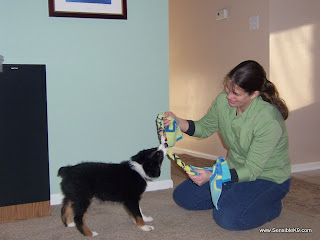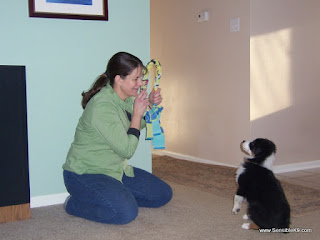
 “Won’t playing Tug-of-War with my dog make him aggressive?”
“Won’t playing Tug-of-War with my dog make him aggressive?” In short, no. I have lived with dozens of dogs of different breeds, personalities and intensities. I have played Tug with all of them. Not one of them ever became aggressive or guarded items from me. Instead, they usually brought me items more readily because I am apt to suggest a game with them! I have counseled hundreds of dog owners to safely play Tug with their dogs. You can, too, so long as your follow some basic rules, listed below. But first, let’s discuss why you should play Tug of War with your dog. Then we’ll cover the how’s of tug and finally the rules to remember.
Why Tug?Ever watch a group of puppies play? Aside from wrestling and biting at each other with mighty puppy growls, a favorite pastime is to grab an item and initiate “chase me” or “tug”. Since puppies naturally enjoy playing tug, I believe it’s important to use the game as a way to teach them self-control and to have soft-mouths toward people. Additionally, some dogs prefer a game of Tug to any food treat or praise reward. For example, my golden retriever earned his agility titles for the simple prospect of a great game of Tug at the end of each of his course-runs. It was the best motivator for him!
Tug can be a great tool to teach bite inhibition. If a puppy is enjoying a tug game and it ENDS the second his teeth touched your skin and you yell, “OUCH!”, your puppy will learn that, in order to keep the fun going, he’d better be more careful with his aim. Attention to this detail carries over to his entire relationship with you… people HURT and fun STOPS when you bite them! A great idea for your puppy to get cemented in his head, early.
Finally, I teach impulse control using Tug. Once a puppy understands to release the toy (which I teach simply by exchanging for a treat or by saying “give” and gently removing it from the puppy’s mouth), I ask the puppy to release the toy and then, Sit. The second the puppy’s rear hits the floor, I quickly bring the tug toy out in front of me, hands far apart, and say, “Get it!” The game resumes. Once puppy understands that his good behavior starts the game again, you can lengthen the duration of the sit, or ask for other behaviors (such as great leash manners, polite greetings and so forth). If the puppy gets up or bites at the tug toy before I give permission, I raise it high in the air or hide it behind my back until the puppy sits again and waits patiently. The puppy learns to wait, to not jump up and grab immediately. This message carries over: If I want something, I am more likely to get it by sitting and waiting, not grabbing.
How To TugFirst, start with the right toy. Fleece is easier on young puppy mouths. Older dogs can usually handle a firmer grip such as that needed with a rope or rubber tug. I like visiting Goodwill or Salvation Army to purchase used fleece blankets. I cut the fabric into long strips and braid them together to make tug toys several feet long. Smaller tug toys can be found, but if I can hold my hands 2 feet apart, the puppy will have a better chance of grabbing the fabric and not my skin, teaching appropriate bite-targeting, in the beginning. If you aren’t “crafty”, you can purchase fleece tugs through your favorite pet supply retailer.
Pull the tug toy along the ground in front of your puppy to get him interested in the item. When he grabs it, give it a gentle shake back and forth. Be careful to keep his front feet on the ground at all times and avoid potentially harmful jerking motions. Young puppies aren’t as tough as they seem, and older dogs are at greater risk of injury.
During tug, it is normal for your puppy to clench his teeth firmly and even to growl. Some sound mighty fierce! Usually, though, it’s just play. To be sure, check the dog’s body language. If the dog’s body remains supple and bendy, wiggly and loose, then it surely is play. However, if his body suddenly becomes stiff, if hackles (the hair between the shoulder blades or on the rump) are raised or if your dog become white-eyed, hard-staring or grabs back a dropped tug with frightening intensity, it’s best to quit the game and consult with a professional. Tug may not be a good game for this dog.
To teach your puppy to grab at the tug and not your hands, begin by having your hands very far apart. You want your puppy to enjoy the game, not to fear doing something wrong. As your puppy gains experience and becomes a tug-enthusiast, work your hands closer together, making the bite-target area smaller until your puppy has to find the bite-target within only 8-12 inches of tug space between your hands. When he is proficient at that, you will know you have a much safer dog for tug games and can begin including other people in the play.
Rules of the Tug Game:1. Dogs with possession issues, guarding behaviors or bite histories should never play Tug.
2. Children under 11 should never play Tug. Generally, they lack the wisdom to keep the game safe. Children older than 11 should be closely supervised by a responsible adult to ensure safety for both dog and child.
3. Human must always be the Tug game initiator. Dog should not offer “Tug” on an item without the person suggesting the game. Tug should only be on a particular type of toy, not all toys.
4. Tug toy must be at least 18 inches long for safety.
5. Dog must immediately release toy when asked. Once a dog has been taught how to do this, failure to release immediately ends the game for at least an hour.
6. Dog must intermittently obey obedience commands (such as Sit or Down) in the middle of a Tug game, in order to earn the right for the game to continue. Failure to comply ends the game.
7. If dog teeth touch human skin (or clothing), the Tug game stops immediately and the toy is put away.
8. Dog should win the toy and bring it back to you. If dog wins the toy and runs away with it, Tug is not a game for that dog without further training.
9. Keep your body loose and supple during tug. Avoid staring into your dog’s eyes or challenging him for a dropped tug toy. Remember, this is FUN and should remain PLAYFUL for all involved.
So, on these wintery days when walks are painful, enhance your relationship and training with your dog by including a fun, safe game of Tug. It won’t make your dog aggressive any more than playing football makes your son a mugger.